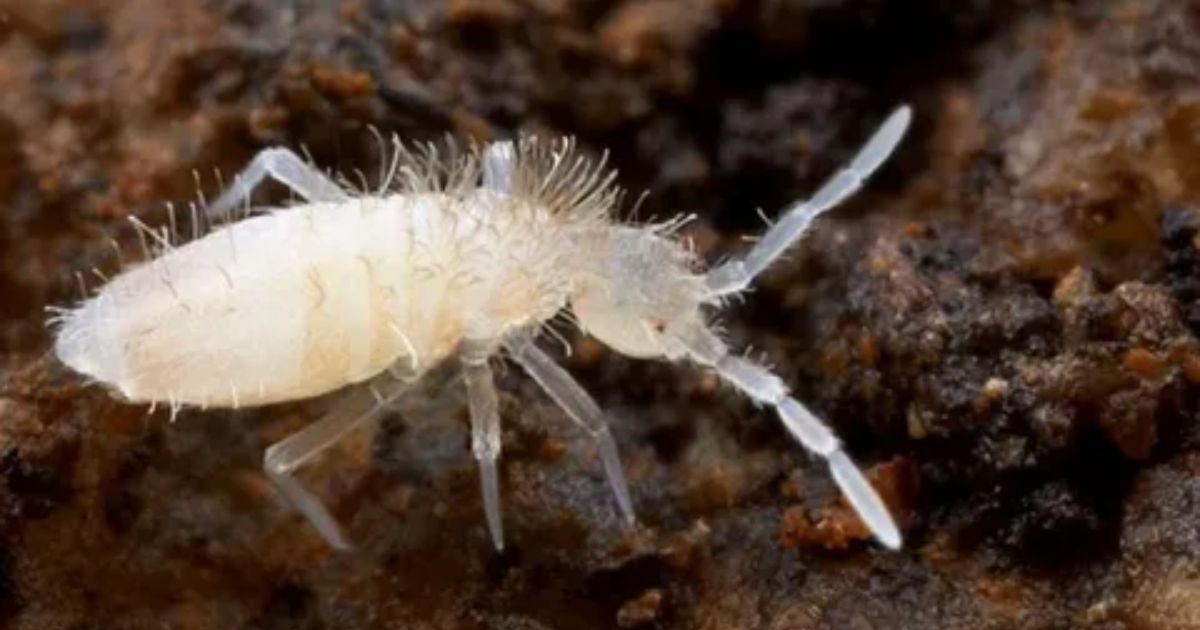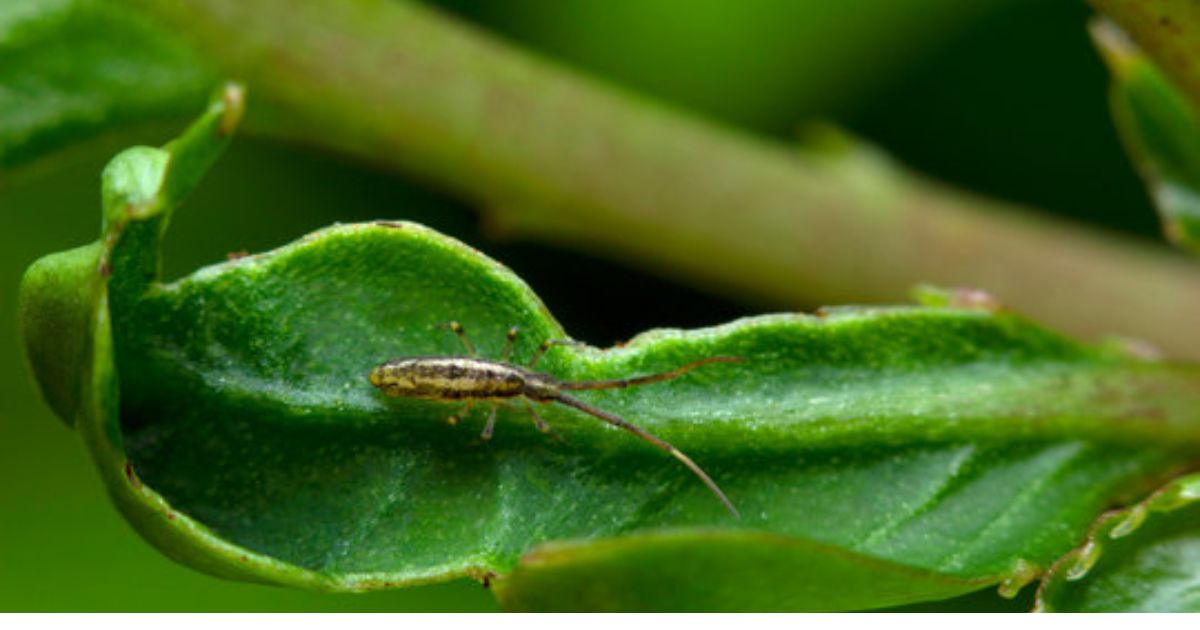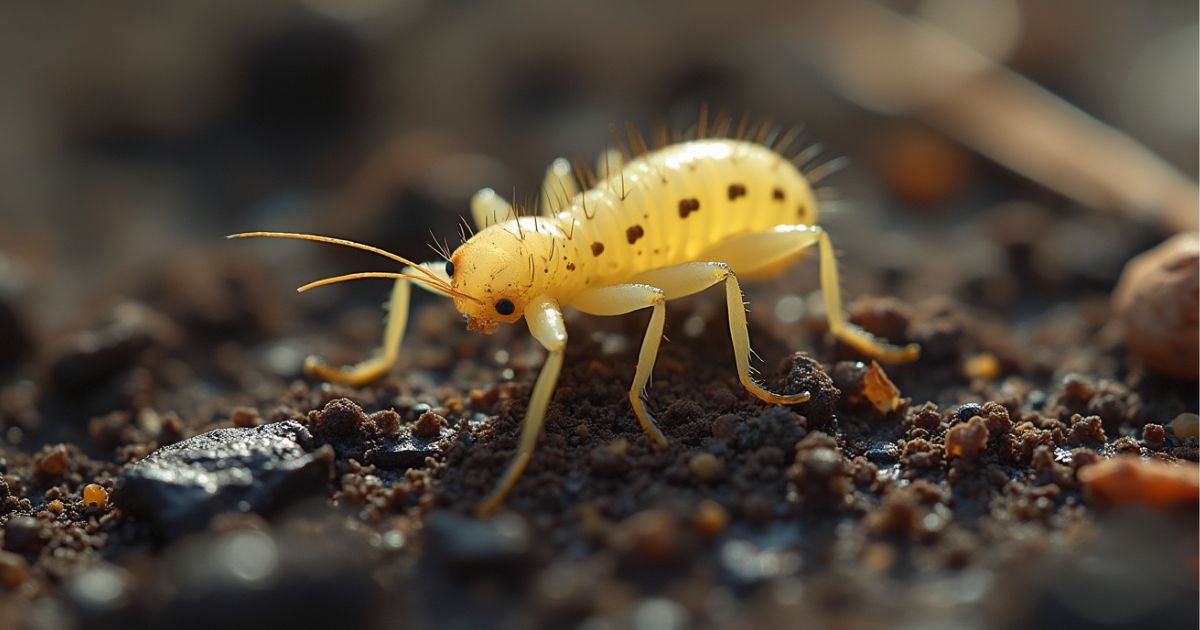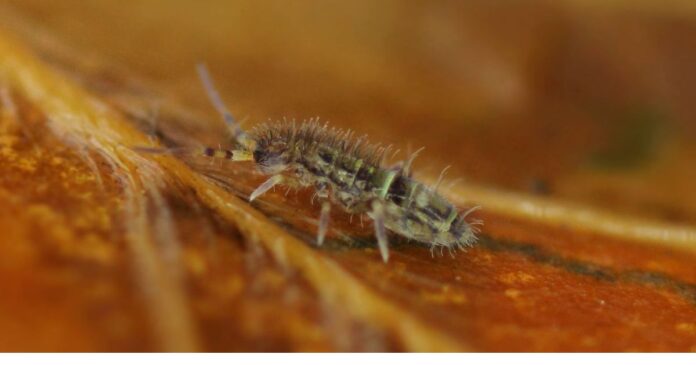Springtails are tiny, jumping insects that often show up in potted plants and indoor grow setups. While they don’t directly harm your cannabis or other plants, their presence is usually a sign of overwatering, high Humidity, or decaying organic matter in the soil. Left unchecked, they can create a nuisance and indicate conditions that may encourage mould or fungus, which may have an impact on your plants‘ health.
If you’re seeing tiny white or grey bugs hopping around your soil or on the plant surface, it’s time to take action. In this guide,how to get rid of springtails we’ll show you why springtails appear, how to safely get rid of them, and what steps to take to prevent them from coming back, all while keeping your weed healthy and thriving.
What Are Springtails?
Springtails are tiny insects, usually measuring less than 6 millimetres, that get their name from a unique appendage called a furcula. This small, tail-like structure allows them to jump long distances relative to their size. They are often white, grey, or light brown and are commonly mistaken for pests like fleas or gnats.These insects thrive in moist, damp environments where decaying organic matter is present. In indoor plants, they are most often found in the top layer of soil, especially in overwatered pots or in soil that hasn’t been properly aerated.

While springtails don’t feed on live plants and are generally harmless, their presence indicates conditions that may lead to mould or fungal growth, How to Identify Small White Bugs in Soil which can indirectly affect your plant’s health. Understanding what springtails are and why they appear is the first step in controlling them effectively in your weed or other indoor plants.Spray vinegar or bleach
Why Springtails Appear in Cannabis/Indoor Plants
Springtails are attracted to conditions that provide moisture, organic matter, and shelter, which makes indoor cannabis or potted plants the perfect habitat for them. Here are the main reasons they appear in your grow setup:
Overwatered Soil
Springtails thrive in consistently damp soil. These tiny insects thrive in the ideal conditions created by overwatering your plants to multiply.
Poor Drainage
Pots or containers without proper drainage trap excess water, keeping the soil wet and inviting springtails.
Organic Debris in Soil
Decaying leaves, leftover plant material, How Much Water Does a Cannabis Plant Need or overly rich compost in the soil can attract springtails because they feed on fungus and decomposing matter, Seal cracks not your plant itself.
High Humidity
Indoor grow rooms or greenhouses with high humidity levels make it easier for springtails to survive and reproduce.
Mould or Fungal Growth
Springtails feed on fungi, Vacuum regularly so the presence of mould in the soil or on plant surfaces can lead to infestations.
Understanding these causes helps you treat the infestation effectively and prevent it from coming back while keeping your cannabis plants healthy.
Signs of Springtails in Plants
Springtails are small and fast-moving, which makes them easy to overlook until their population increases. Spotting them early helps prevent moisture-related problems in your cannabis or indoor plants. Use dehumidifier Here are the key signs to look for:
Tiny Jumping Insects on the Soil Surface
When you water your plants or disturb the soil, you may notice tiny white, grey, or black bugs jumping around. amyron syrup uses in hindi These are springtails using their tail-like structure (furcula) to hop away from disturbance.
Insects Around Drainage Holes or Trays
Springtails often gather near the bottom of pots, where moisture collects. Check around drainage holes, saucers, or trays under your plants.
Presence of Mould or a Musty Smell
A springtail infestation usually accompanies mould or fungus growth, which produces a musty odour. This indicates your soil is staying too damp.
Damp, Constantly Wet Soil
If the top layer of soil never dries out, Fix leaks likely creating a breeding ground for springtails.
Springtails on Leaves or Grow Room Walls
In severe cases, springtails may crawl up plant stems or appear on nearby walls, especially in humid grow tents or greenhouses.
While springtails are not directly harmful to your plants, their presence signals that the growing environment is too moist or poorly ventilated, Dry Herb Vaporizer Guide: Everything You Need to Know Before Buying which can lead to root rot or fungal disease if not corrected.
Detailed Instructions for Eliminating Springtails from Weed Plants
If you’ve confirmed that springtails are living in your cannabis soil, don’t panic; they’re manageable. The key is to remove excess moisture, clean the soil, and restore balance to your grow environment. Follow these simple steps:
Reduce Moisture and Let the Soil Dry Out
Springtails can’t survive in dry conditions. Start by:
- Allowing the soil to dry between waterings, wait until the top 1–2 inches feel completely dry.
- Avoid daily watering; water only when the plants truly need it.
- Checking that pots have proper drainage holes so water doesn’t sit at the bottom.
This single step often reduces springtail numbers dramatically within a few days.
Clean the Soil Surface
- Remove the top layer of soil (about 1 inch) if it’s heavily infested, Tips for Growing the Popular Slurricane Strain at Home and replace it with fresh, dry, sterile soil.
- Discard any fallen leaves or decaying organic matter on the surface.
- Avoid leaving mulch or compost on top of the potting mix in indoor grows.
Improve Air Circulation and Reduce Humidity

Springtails love humid air. Lowering Humidity helps stop their reproduction.
- Use fans to keep air moving around your grow area.
- Run a dehumidifier if humidity levels stay above 60%.
- Keep grow tents or rooms well-ventilated.
Use Natural Remedies to Kill Springtails
These natural methods are safe for cannabis and indoor plants:
- Diatomaceous Earth (DE): Sprinkle food-grade DE on the top of the soil. It kills springtails by drying them out.
- Neem Oil Spray or Soil Drench: Mix 1–2 litres of water, a few drops of neem oil, and a few tablespoons of mild soap. Spray it on the soil and lower plant stems.
- Cinnamon Powder: Lightly dust the soil surface; Best Soil Mixture for Cannabis it helps control fungus and deter springtails.
- One part white vinegar to four parts vinegar is the vinegar solution. Water can be sprayed lightly around infested areas (avoid soaking the soil).Repeat treatments 2-3 months
Try Beneficial Predators (Optional)
For organic growers, adding beneficial insects can naturally reduce springtail populations.
- Hypoaspis miles (Stratiolaelaps scimitus) is a soil-dwelling predatory mite that feeds on springtails and fungus gnat larvae.
- These can be purchased from garden suppliers and added directly to the soil.
Chemical Control (Last Resort)
If the infestation is significant or persistent:
- Use a mild, plant-safe insecticide or insecticidal soap.
- Always test on one plant first to ensure it doesn’t harm your cannabis.
- Avoid harsh chemicals that may leave residue in soil or affect your buds.
Maintain Clean Growing Conditions
After treatment:
- Keep grow areas dry, clean, and well-aerated.
- Sanitise trays, saucers, and equipment regularly.
- Avoid bringing in unsterilized soil or outdoor plants that may carry springtails.
By following these steps consistently, you’ll eliminate existing springtails and prevent new ones from coming back, all while keeping your weed plants safe and healthy.
Preventing Future Springtail Infestations
Once you’ve gotten rid of springtails, action must be taken to prevent their return. Prevention is easier and safer for your plants than dealing with another infestation later. Follow these proven prevention methods to keep your cannabis or indoor plants springtail-free:
Water Wisely
Overwatering is the number one reason springtails appear.
- Water only when necessary. Check soil moisture before watering; abhayarishta uses in marathi the top 1–2 inches should be dry first.
- Use well-draining soil so excess water can escape.
- Empty drain trays or saucers regularly to prevent standing water.
Improve Drainage and Soil Quality
- Mix in perlite, coco coir, or sand to keep the soil light and airy.
- Avoid compacted or heavy soil that traps moisture.
- Always use sterile, high-quality soil to prevent introducing pests or mould spores.
Maintain Proper Humidity Levels
Springtails thrive in humid environments.
- Keep Humidity around 40–55% for most indoor cannabis grows.
- Use a dehumidifier or increase Airflow if the Humidity stays high.
- Make sure your grow room or tent has proper ventilation and exhaust fans.
Keep the Grow Area Clean
- Regularly wipe down grow tent walls, trays, and surfaces.
- Pots should have any dead leaves or organic waste removed right away.
- Disinfect tools and equipment to avoid cross-contamination.
Avoid Over-Fertilizing or Over-Amending Soil
- Too much organic material (like compost or worm castings) can feed fungi, which attracts springtails.
- Keep amendments balanced and monitor soil condition over time.
Inspect New Plants and Soil Before Bringing Them In
- Quarantine new plants for a few days before placing them near your grow.
- Check the soil for any signs of movement or damp patches.
- Only use trusted soil brands or pasteurized soil when starting new grows.
Use Beneficial Microbes and Predators
Maintaining a healthy soil ecosystem helps keep pests away naturally.
- Introduce beneficial nematodes or predatory mites to the soil to control unwanted insects.
- Encourage microbial life that keeps the soil balanced and free of mould.
By keeping your grow room clean, dry, and balanced, you create an environment where springtails can’t survive. Consistent moisture control, good Airflow, and regular maintenance are the keys to long-term prevention, ensuring your cannabis plants stay healthy, pest-free, and thriving.
Preventing Future Springtail Infestations
Once you’ve managed to remove springtails from your weed plants, prevention becomes your best defence. These insects thrive in damp, humid, and poorly ventilated environments, so your goal is to keep conditions dry, clean, and balanced. Here’s how you can prevent them from coming back:
Practice Smart Watering Habits
Overwatering is the leading cause of springtail problems.
- Check moisture before watering: If your finger is still wet after sticking it approximately an inch into the ground, give it another day or two.
- Let the soil dry out between waterings: Springtails can’t survive in dry conditions.
- Use pots with good drainage: Always ensure that the bottom of your containers does not leak extra water.
- Empty drip trays promptly: Standing water attracts moisture-loving pests.
Use the Right Soil Mix
Healthy soil prevents many pest issues.
- Choose a light, well-aerated soil with perlite or coco coir for better drainage.
- Avoid using heavy compost or manure-based soil indoors, as it retains too much moisture.
- Always sterilize reused soil or buy fresh, pest-free soil for each new grow cycle.
Control Humidity and Improve Airflow
Springtails reproduce quickly in humid air.
- Maintain grow room humidity around 40–55%.
- Use a dehumidifier or oscillating fans to increase Airflow.
- Keep air circulating evenly around your plants to prevent stagnant, damp pockets.
Keep Your Grow Space Clean
Cleanliness is key to long-term prevention.
- Remove dead leaves, soil debris, and organic waste promptly.
- Wipe down grow tent walls, trays, and tools regularly with mild disinfectant.
- Wash and dry all pots before reusing them.
Avoid Over-Fertilizing
- Excess organic matter, especially from compost teas or slow-release fertilizers, can attract springtails.
- Stick to a balanced feeding schedule and monitor soil buildup.
Inspect New Plants and Soil Before Bringing Them Indoors
- Before planting new plants, always look for indications of pests. To your grow space.
- If possible, quarantine new additions for a few days.
- Only buy trusted soil brands or sterilize soil before use.
Maintain Healthy Soil Biology

- Encourage beneficial microbes by using compost teas or microbial inoculants, which help balance the soil and outcompete pests.
- Consider adding beneficial predators like Hypoaspis miles, which feed on springtails naturally.
By maintaining a dry, well-ventilated, and clean environment, you’ll prevent springtails from ever becoming a problem again. Remember, a balanced grow setup isn’t just pest-free, it also supports healthier roots and more vigorous plants overall.
Conclusion
Springtails may be small, but their presence signals a bigger issue: too much moisture and poor Airflow in your grow environment. While these tiny jumpers don’t directly harm your cannabis plants, they thrive in the same damp conditions that promote mould, fungus, and root problems.
The good news is that you can eliminate and prevent springtails naturally by following simple steps: enhance drainage, let the soil dry up, reduce Humidity, and keep your grow space clean. Using natural treatments like diatomaceous earth, neem oil, or cinnamon powder adds an extra layer of control without risking your plant’s health.
Consistent maintenance is the key. Once you find the right balance of moisture and Airflow, springtails won’t stand a chance, and your weed plants will reward you with stronger roots, healthier growth, and higher-quality yields.
FAQ
Are springtails harmful to cannabis plants?
No, springtails don’t harm cannabis plants directly. They feed on decaying organic matter, mould, and fungi in the soil. However, their presence signals that the soil is too damp, which can lead to fungal or root issues if not corrected.
What causes springtails to appear in weed soil?
Springtails appear when the soil stays constantly wet or humid. Overwatering, poor drainage, and decaying organic matter create perfect conditions for them to thrive.
How do I get rid of springtails naturally?
The best natural methods include letting the soil dry out, improving drainage, and using diatomaceous earth, neem oil, or cinnamon powder on the soil surface. These treatments are safe for cannabis and effective at reducing springtail populations.
Can springtails spread to other plants?
Yes. Springtails can move between pots or containers, especially in shared grow rooms or greenhouses with high Humidity. Keeping your grow area dry and clean helps prevent spreading.
What kills springtails instantly?
Diatomaceous earth and insecticidal soap sprays can kill springtails quickly on contact. However, for long-term control, it’s better to fix the underlying cause of excess moisture.
Will springtails go away on their own?
If you reduce watering and lower Humidity, springtails often disappear naturally within a few days to weeks. They can’t survive in dry environments.




